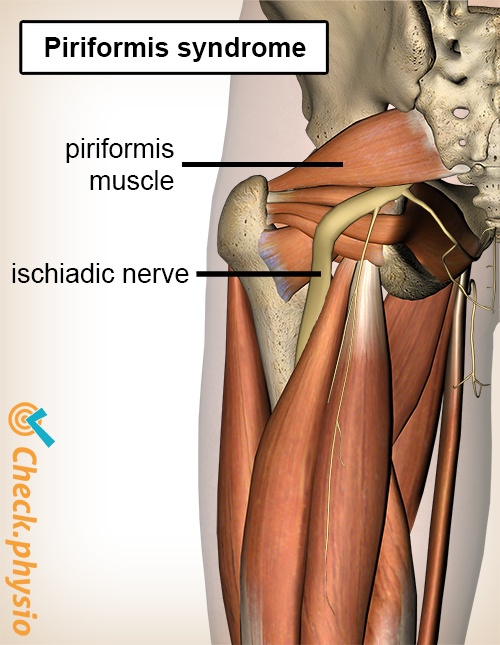- Conditions
- Piriformis syndrome
Piriformis syndrome Compression of the sciatic nerve
Introduction
Piriformis syndrome is characterised by pain in the buttock region. The symptoms occur when the deeper buttock muscle irritates a nerve that runs from the back to the leg. This can also result in symptoms that radiate to the leg.
The diagnosis is difficult to make. The symptoms are often confused with other conditions.

Description of the condition
The sciatic nerve (also called ischiadic nerve) is the large hip nerve that runs from the buttock to the leg. Before the nerve enters the leg it must first move past a deeper buttock muscle: the piriformis. The nerve can become compressed or irritated here. It is thought that this is caused by a shortened piriformis, swelling or increased muscle tension.
Cause and origin
The symptoms occur after an accident or fall on the buttock, or can be the result of an anatomical abnormality. This is because the sciatic nerve does not run past the piriformis in the same way for everyone. The nerve can run under the muscle (in 85 % of cases) or partially through the muscle (in 15 % of cases) or partially over the muscle (in 0.5 % of cases).
Signs & symptoms
- Pain in the buttock region.
- Sitting makes the symptoms worse.
- There is deep pressure pain in the middle of the buttock.
- The symptoms can increase during cycling or running.
- Sometimes the pain radiates to the leg over the course of the nerve.
- The (passive) inward rotation of the hip can be painful.
- Flexing the hip with the knee extended can provoke the symptoms (SLR test).
- This is not normally associated with back pain.
Diagnosis
It is often difficult to make the diagnosis. Hence, there is still much ambiguity and discussion. The symptoms are also often mistaken for other conditions.
There are few, if any, good additional examinations that can confirm the diagnosis. Therefore, it is often referred to as a clinical diagnosis. This implies that a physician or physiotherapist makes the diagnosis, without additional examinations. Through the story and various physical tests, a clinical diagnosis can be made.
Direct pressure on the opening through which the nerve runs is painful. There are also a number of physical tests that can induce the symptoms. If some of these tests are positive and there is pressure pain at the opening then the diagnosis is made.
An MRI scan, nerve examination (EMG) or ultrasound examination often shows no problems to the nerve or piriformis. Hence, additional examination is usually not useful.
Treatment and recovery
Physiotherapy can decrease the muscle tension (tonicity) of the piriformis. Mobilisation techniques are used to optimise the free space of the sciatic nerve. In addition, exercise therapy is used.
Other forms of treatment include medication, an injection or - in rare cases - a surgical procedure.
Exercises
There are several exercises you can do for the piriformis syndrome. See here the exercise programme with exercises for the piriformis syndrome.
More info
You can check your symptoms using the online physiotherapy check or make an appointment with a physiotherapy practice in your area.
References
Hopayian, K., Song, F., Riera, R. & Sambandan, S. (2010) The clinical features of the piriformis syndrome: A systematic review Eur Spine J. 2010 Dec;19(12):2095-109.
Schünke, M., Schulte, E. & Schumacher, U. (2005) Prometheus. Algemene anatomie en bewegingsapparaat Houten: Bohn Stafleu Van Loghum.
